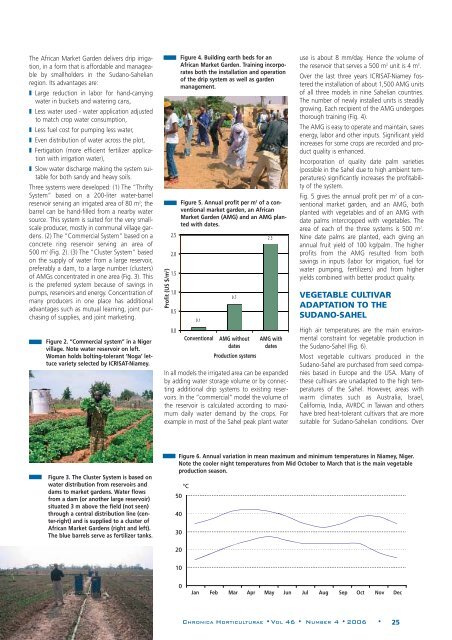Chronica - Acta Horticulturae
Chronica - Acta Horticulturae
Chronica - Acta Horticulturae
You also want an ePaper? Increase the reach of your titles
YUMPU automatically turns print PDFs into web optimized ePapers that Google loves.
The African Market Garden delivers drip irrigation,<br />
in a form that is affordable and manageable<br />
by smallholders in the Sudano-Sahelian<br />
region. Its advantages are:<br />
❚ Large reduction in labor for hand-carrying<br />
water in buckets and watering cans,<br />
❚ Less water used - water application adjusted<br />
to match crop water consumption,<br />
❚ Less fuel cost for pumping less water,<br />
❚ Even distribution of water across the plot,<br />
❚ Fertigation (more efficient fertilizer application<br />
with irrigation water),<br />
❚ Slow water discharge making the system suitable<br />
for both sandy and heavy soils.<br />
Three systems were developed: (1) The “Thrifty<br />
System” based on a 200-liter water-barrel<br />
reservoir serving an irrigated area of 80 m 2 ; the<br />
barrel can be hand-filled from a nearby water<br />
source. This system is suited for the very smallscale<br />
producer, mostly in communal village gardens.<br />
(2) The “Commercial System” based on a<br />
concrete ring reservoir serving an area of<br />
500 m 2 (Fig. 2). (3) The “Cluster System” based<br />
on the supply of water from a large reservoir,<br />
preferably a dam, to a large number (clusters)<br />
of AMGs concentrated in one area (Fig. 3). This<br />
is the preferred system because of savings in<br />
pumps, reservoirs and energy. Concentration of<br />
many producers in one place has additional<br />
advantages such as mutual learning, joint purchasing<br />
of supplies, and joint marketing.<br />
Figure 2. “Commercial system” in a Niger<br />
village. Note water reservoir on left.<br />
Woman holds bolting-tolerant ‘Noga’ lettuce<br />
variety selected by ICRISAT-Niamey.<br />
Profit (US $/m 2 )<br />
2.5<br />
2.0<br />
1.5<br />
1.0<br />
0.5<br />
0.0<br />
Figure 4. Building earth beds for an<br />
African Market Garden. Training incorporates<br />
both the installation and operation<br />
of the drip system as well as garden<br />
management.<br />
Figure 5. Annual profit per m 2 of a conventional<br />
market garden, an African<br />
Market Garden (AMG) and an AMG planted<br />
with dates.<br />
0.1<br />
Conventional<br />
In all models the irrigated area can be expanded<br />
by adding water storage volume or by connecting<br />
additional drip systems to existing reservoirs.<br />
In the “commercial” model the volume of<br />
the reservoir is calculated according to maximum<br />
daily water demand by the crops. For<br />
example in most of the Sahel peak plant water<br />
0.7<br />
AMG without<br />
dates<br />
Production systems<br />
2.3<br />
AMG with<br />
dates<br />
use is about 8 mm/day. Hence the volume of<br />
the reservoir that serves a 500 m 2 unit is 4 m 3 .<br />
Over the last three years ICRISAT-Niamey fostered<br />
the installation of about 1,500 AMG units<br />
of all three models in nine Sahelian countries.<br />
The number of newly installed units is steadily<br />
growing. Each recipient of the AMG undergoes<br />
thorough training (Fig. 4).<br />
The AMG is easy to operate and maintain, saves<br />
energy, labor and other inputs. Significant yield<br />
increases for some crops are recorded and product<br />
quality is enhanced.<br />
Incorporation of quality date palm varieties<br />
(possible in the Sahel due to high ambient temperatures)<br />
significantly increases the profitability<br />
of the system.<br />
Fig. 5 gives the annual profit per m 2 of a conventional<br />
market garden, and an AMG, both<br />
planted with vegetables and of an AMG with<br />
date palms intercropped with vegetables. The<br />
area of each of the three systems is 500 m 2 .<br />
Nine date palms are planted, each giving an<br />
annual fruit yield of 100 kg/palm. The higher<br />
profits from the AMG resulted from both<br />
savings in inputs (labor for irrigation, fuel for<br />
water pumping, fertilizers) and from higher<br />
yields combined with better product quality.<br />
VEGETABLE CULTIVAR<br />
ADAPTATION TO THE<br />
SUDANO-SAHEL<br />
High air temperatures are the main environmental<br />
constraint for vegetable production in<br />
the Sudano-Sahel (Fig. 6).<br />
Most vegetable cultivars produced in the<br />
Sudano-Sahel are purchased from seed companies<br />
based in Europe and the USA. Many of<br />
these cultivars are unadapted to the high temperatures<br />
of the Sahel. However, areas with<br />
warm climates such as Australia, Israel,<br />
California, India, AVRDC in Taiwan and others<br />
have bred heat-tolerant cultivars that are more<br />
suitable for Sudano-Sahelian conditions. Over<br />
Figure 3. The Cluster System is based on<br />
water distribution from reservoirs and<br />
dams to market gardens. Water flows<br />
from a dam (or another large reservoir)<br />
situated 3 m above the field (not seen)<br />
through a central distribution line (center-right)<br />
and is supplied to a cluster of<br />
African Market Gardens (right and left).<br />
The blue barrels serve as fertilizer tanks.<br />
Figure 6. Annual variation in mean maximum and minimum temperatures in Niamey, Niger.<br />
Note the cooler night temperatures from Mid October to March that is the main vegetable<br />
production season.<br />
50<br />
40<br />
30<br />
°C<br />
20<br />
10<br />
0<br />
Jan Feb Mar Apr May Jun Jul Aug Sep Oct Nov Dec<br />
CHRONICA HORTICULTURAE •VOL 46 • NUMBER 4 • 2006 • 25
















